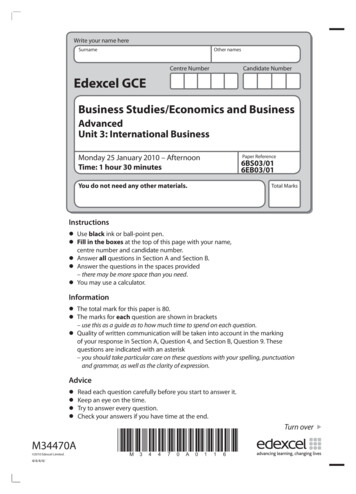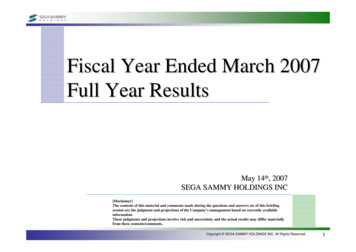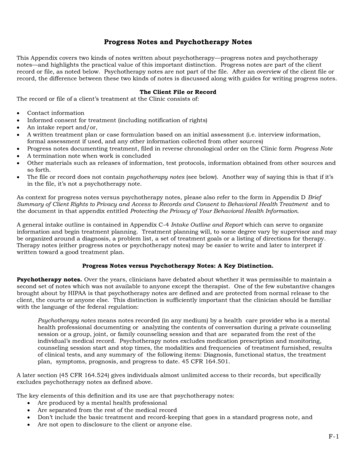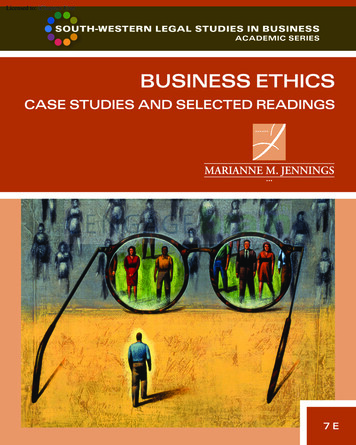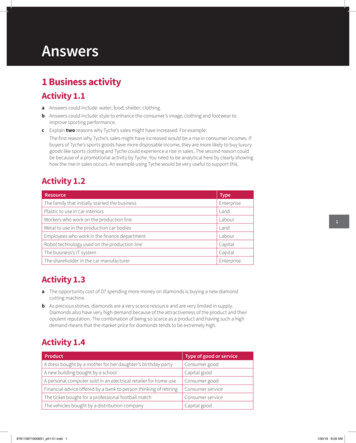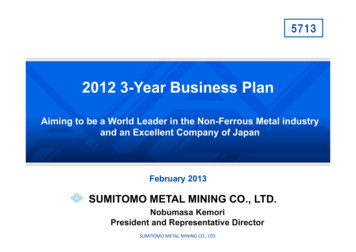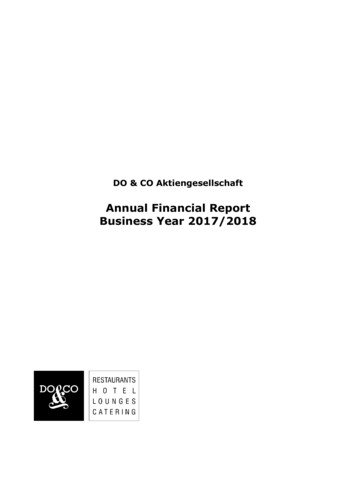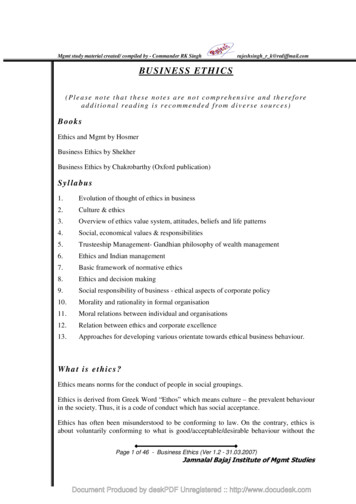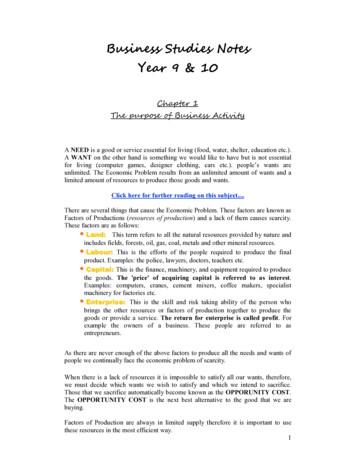
Transcription
Business Studies NotesYear 9 & 10Chapter 1The purpose of Business ActivityA NEED is a good or service essential for living (food, water, shelter, education etc.).A WANT on the other hand is something we would like to have but is not essentialfor living (computer games, designer clothing, cars etc.). people’s wants areunlimited. The Economic Problem results from an unlimited amount of wants and alimited amount of resources to produce those goods and wants.Click here for further reading on this subject.There are several things that cause the Economic Problem. These factors are known asFactors of Productions (resources of production) and a lack of them causes scarcity.These factors are as follows: Land: This term refers to all the natural resources provided by nature andincludes fields, forests, oil, gas, coal, metals and other mineral resources. Labour: This is the efforts of the people required to produce the finalproduct. Examples: the police, lawyers, doctors, teachers etc. Capital: This is the finance, machinery, and equipment required to producethe goods. The 'price' of acquiring capital is referred to as interest.Examples: computers, cranes, cement mixers, coffee makers, specialistmachinery for factories etc. Enterprise: This is the skill and risk taking ability of the person whobrings the other resources or factors of production together to produce thegoods or provide a service. The return for enterprise is called profit. Forexample the owners of a business. These people are referred to asentrepreneurs.As there are never enough of the above factors to produce all the needs and wants ofpeople we continually face the economic problem of scarcity.When there is a lack of resources it is impossible to satisfy all our wants, therefore,we must decide which wants we wish to satisfy and which we intend to sacrifice.Those that we sacrifice automatically become known as the OPPORUNITY COST.The OPPORTUNITY COST is the next best alternative to the good that we arebuying.Factors of Production are always in limited supply therefore it is important to usethese resources in the most efficient way.1
Refer to page 4 in textbook for exampleOver time production methods change. Machinery is now more widely used toproduce goods than before, and large firms are more common than they used to be.These firms employ specialised workers for special tasks.Specialisation and DivisionThe reason these large firms are so successful is because they employ the productionmethods of SPECIALISATION and DIVISION. A firm using this method employsa large labour workforce and then distributes the work equally amongst them. Thiscan lead to a rise in production levels. However, this method has advantages as wellas disadvantages.Advantages DisadvantagesWorkers are trained in one task andspecialise in it – this leads to increasedefficiency and output.Less time is wasted moving from oneworkbench to another. Workers may become bored doingone job – efficiency may fall.If one worker is absent and no oneelse can do his job then productionmay stop.Summary People have unlimited wants. The four factors of production are in limited supply. Scarcity is a result of limited resources and unlimited wants. Choice is necessary when resources are limited and this leads to opportunitycost. Specialisation and Division lead to improved efficiency and high productionoutput.LinksClick here to revise at BBC Bitesize.2
Chapter 3Forms of business organisationThere are five main types of business organisations in the private sector:1.2.3.4.5.6.7.8.Sole TradersPrivate Limited CompaniesPublic Limited CompaniesPartnershipsCo-operativeFranchisesJoint VenturesClose CorporationsSole TraderA sole trader is a very common form of business organisation. It is owned andoperated by a single person. The sole proprietor can employ more people if he wants.One of the main reasons it is very common is because it requires very few legalformalities. Only the following regulations must be followed:1. The name of the business is very important. In some countries it must beregistered with the Registrar of Business Names. In the UK it is sufficientenough that all the business’s documents have the firm’s name on them. It isalso required a notice with the name of the owner be placed at the main office.2. The sole trader must register with and submit an annual record of accounts tothe Tax Office3. In some industries it is necessary that the sole trader follow certain regulationslike health and safety laws. The sole trader may also have to obtain a licenceto operate a car or sell alcohol.Advantages of a sole trader:1.2.3.4.5.6.Few legal formalitiesComplete controlFreedom of how to manage businessPersonal contact with customers.Profit motive provides incentive to work harder.Secrecy where concerned with business matters.3
Disadvantages of a Sole Trader:1. There is no one to discuss business matters with.2. The owner does not benefit from limited liability. The business is not aseparate legal unit. The business’s accounts cannot be separated from theowner’s accounts. This means the owner is responsible for any of the debts thebusiness may run into. If the owner can’t pay the money his creditors canforce him or her to sell their personal property to pay their debts.3. There is limited capital available to expand the business. The business’sfinancial sources are limited to the owner’s profits, savings and small bankloans. Banks usually hesitate to give large sums of money to such small firms.4. Due to the size of the business the owner cannot afford to employ specialiststo perform certain tasks; like managing the accounts of the business. As aresult the owner may be forced to do certain things he is not skilled at.5. The business is likely to stay small without any capital. It will not benefit fromeconomies of scale. Due to the small size of the business it is very hard to findgood recruits; no training or opportunities can be provided for their futurecareers.6. After the death of the owner the business will cease to exist; since after thedeath of the owner there is no business continuity.PartnershipA partnership is an association of between 2 or 20 people. The various partners willtake a share of any of the profits, have a say in how the business is managed andcontribute to the capital. A partnership can be formed quite quickly. For example asole trader could simply ask a friend to become his partner in a business. This is averbal agreement. The sole trader would be advised to draw up a written agreementknown as a Deed of Partnership or Partnership agreement. Without a Deed ofPartnership the owners may disagree with other about who contributed the mostcapital or who deserves the most amount of the profit. A written agreement settles allthese matters.A Limited Liability Partnership (LLP) could be formed after the year 2000 in the UK.However, shares in the business can’t be sold. The business is a separate legal unitand its accounts are separate from that of the owner. As a result the business continuesto function even if one of the owners die and the partners of a business have limitedliability.Private Limited Company4
The main difference between an unincorporated business and a company is that thecompany is a separate legal unit. This means:1. The company can make contacts and legal agreements.2. The company’s accounts are kept separate from the owners.3. The company exists separately from the owner and there is business continuityeven if one owner dies.Companies are jointly owned by people who invest in the business. These peoplebuy shares and are known as shareholders. They in turn elect directors to run thebusiness. The directors are usually the most important or majority shareholders.This is not the case in a public limited company.Advantages Shares sold to relatives or friends of owners Large sums of capital raised Business expands rapidly Shareholders have limited liability Shareholders encouraged to buy more shares due to this Shareholders only lose money invested into business if business fails Important to know what kind of organisation you are dealing with i.e.private limited, public limited etc UK Limited or Ltd. Other countries Pty (Ltd.) Proprietary Limited Original owners can maintain control over business Must take care to sell too many shares to othersPublic Limited CompanyThis type of business organisation is well suited to large businesses. Most businesseswhich are well known to the public because they own many factories and large chainsof shops are public limited companies.In the UK a:1. Private Limited Company uses the short form of Limited or Ltd.2. Public Limited Company uses the short form Plc.In other parts of the world like South Africa a:1. Private Limited Company uses the short form Proprietary Limited or (Pty)Ltd.2. Public Limited Company uses the short form Limited.5
Conversion from a Private Limited Company to aPublic Limited Company1. A statement in the Memorandum of Association must state that the company isnow a Public Limited Company.2. The accounts must be drawn up in a certain way and submitted to the Registrarof Companies; the public will have access to these accounts.3. An amount of shares of a certain value must be issued ( 50,000 in UK).4. The company will apply to be listed on the Stock Exchange so as to allow itsshareholders to buy and sell shares easily. The Stock Exchange will check thecompany’s trading history and accounts to make sure the business is runproperly.Once these steps are followed then the company must issue a prospectus. This is aformal and detailed document that invites the public to buy shares in the business. Itcontains detailed information on the past of the business and the future plans of thebusiness. Reasons for how the capital is to be raised and spent must be stated.Control and ownership of a Public Limited CompanyIn all sole trader organisations and partnerships the business is controlled buy theowners. They decide how to manage and run the business so as to accomplish theiraims. This is also true in Public Limited Companies as there are very fewshareholders. The directors are the majority shareholders and can ensure thatdecisions are passed at each meeting.In a public limited company things are quite different. There are often thousands evenmillions of shareholder (in the largest companies) and it is impossible for all thesepeople to take part in a decision. However, they do congregate at the Annual GeneralMeeting (AGM). The only real impact the shareholders can have at this meeting is theelection of the company directors. They are tasked with running the business andtaking decisions. They can’t possibly run the business alone so they appoint managersto take day to day decisions.The shareholders own but the directors and managers control. This is known as thedivorce between ownership and control. This is very important for the shareholderswho have risked there money by investing into the business. The managers anddirectors may start to run the business to satisfy their own aims. These could beincreased status, growth of the business to justify higher management salaries andreduction of dividends so as to pay for expansion projects. The shareholders have nocontrol over these decisions other than electing new directors. This could provide badpublicity for the company and lead to n unstable business since the new directorsmaybe inexperienced.Many companies have a divorce of ownership and control, meaning the owners andthose who control the firm (managers) are different groups with different objectives.6
The owners will more than likely wish to pursue a profit maximising objective;however the managers will more than likely have their own agenda. Managers maywish to have an easy life or maximise their prestige, the pursuit of these goals willlead to increasing costs and therefore profits will fall. This behaviour is described asprofit satisfying; the managers make enough profit to keep the shareholders happy,while enjoying as many perks as possible.Co-operativesCo-operatives are groups of people who agree to work together and pool theirresources. They can take various forms but they all have similar features:1. Each member has one vote no matter how many shares he owns.2. Profits are shared equally.3. All members help in running the business. The work load and decision takingare shared equally. In larger co-operatives a manager is appointed to take dayto day decisions.There are two types of co-operatives that exist in the UK:1. Producer Co-operatives: are groups of workers who design and manufactureproducts like many other manufacturing businesses.2. Retail Co-operatives: aim at providing customers with high quality goods andservices at a reasonable price.In other parts of the world co-operatives exist mainly in the agriculture business. Thevarious members try to secure the purchase of materials in bulk so as to benefit fromeconomies of scale. They also collect all of the member’s produce at sell at attractiveprices to big customers. The farmers who are part of such co-operatives would notgain from these benefits if they traded individually.Close CorporationsSuch corporations do not exist in the UK; however, they are actively encouraged inother countries like South Africa. They are similar to Private Limited Companies butcan be set up quite easily. There are fewer regulations to follow and much less rulesgoverning how they are to be managed.1. The number of members is limited to ten people.2. Only a simple founding statement needs to be sent to the Registrar ofCompanies.3. The members are also the managers (no separation between ownership andcontrol).4. The business is a separate legal unit. Thus, there is business continuity even ifone of the owners dies and the owners have limited liability.7
Disadvantages1. The amount of members is limited to 10 people making it unsuitable for largebusinesses.2. The various partners may disagree on many decisions.Joint VenturesA joint venture is when two or more companies start a project together. They sharethe risks, profits and capital. Many European companies have begun joint ventureswith Chinese companies in China. The local managers have good experience in thelocal tastes and needs.FranchiseThis is now a widespread way of doing business. The franchisor is a business with aproduct or idea that it does not want to sell directly to the customer. Instead itauthorises a franchisee to sell its product or idea directly to the customer. Examplesare McDonalds and The Body iness/aims/limitedcompaniesrev2.shtmlBusiness Organisations: the public sectorThe public sector is an important part of any nation’s economy. The public sectorincludes all the businesses owned and controlled by the government and state, publicservices like schools, hospitals, fire services etc and government departments.There are two main types of business organisations in this sector:1. Public Corporations2. Municipal EnterprisesPublic CorporationsThese are wholly owned by the state or government. They are usually businesses thathave been nationalised. This means they used to be owned by private individualsbefore the government bought them. Examples: water supply and rail service. Publiccorporations are owned by the government but they do not directly operate them.Instead the ministers of the government appoint a board of directors to run andmanage the business. The government also provides a set of objectives which thedirectors are expected to follow.These objectives have changed over time in most countries. In the past corporationsused to be given social objectives, like:8
1. To keep the prices of the products provided low so that everyone can affordthem.2. To keep people in jobs so as to prevent a rise in unemployment.3. To offer the service in all parts of the country.However, by following these aims these public corporations began to make heavylosses. To cover these losses the government provided subsidies. The governmentrealised it couldn’t continue to provide these subsidies. Thus, they made certainchanges to the corporation’s objectives, like:1. To reduce costs by making some workers redundant.2. To stop servicing loss making areas.3. To increase efficiency and operate more like a business in the private sector.This policy of operating more like a business in the private sector (corporatisation)meant these corporations were being readied for privatisation.Chapter 11Managing a BusinessAll organisations have managers. They may not be called managers but instead havedifferent titles; headmaster, director, leader etc. The following are the tasks that allmangers will take over a period of time:Planning for the future of the organisation involves setting aims or targets.These aims give the organisation a sense of direction. There will be a commonfeeling of having to work towards something. A poor manager will not planfor the future. In addition to setting these aims managers must plan for theresources that will be needed.Managers cannot do everything by themselves. Tasks must be delegated tosubordinates and they must have their correct resources to complete their taskseffectively. Hence, managers must organise resources and people effectively.Co-ordinating means bringing together. A manager may excel at planning andorganising but he/she may fail to bring the organisation together. This a realdanger to the functional form of the organisation. For example, what is the useof the Marketing Department planning the release of a new product withoutinforming the Production Department? In the end it will be up to theProduction Department to make the product at the right time in the rightquantities. A good manager will ensure that the departments work together toreach the set aims.9
Commanding where managers provide guidance, lead and superviseemployees. Managers ensure they reach their targets and that instructionsreach all employees.Controlling where the manager evaluates and measures the progress ofemployees. They ensure that they meet the set aims and if not they will bedisciplined appropriately. However, there maybe reasons for poor performanceother than inefficient workers.With a poor management a business will lack: A sense of control and purpose. Coordination between departments Control over workers Organisation of resources leading to low output and sales.The qualities of a good manager include:1. Initiative2. Intelligence3. Self confidence4. Communication skills5. Enthusiasm and energyStrategic decisions: are vital to the organisation’s overall success. These are taken bythe senior management and include takeovers, mergers and acquisitions.Tactical Decisions: taken more frequently and of less importance.Operational Decisions: are day to day decisions taken by lower levels ofmanagement.Decision Making Process:1. Set objectives for the business.2. Identify and analyze problem at hand.3. Collect data4. Consider options and implement final decision.5. Review and evaluate success.Chapter 12Communication in a businessCommunication is the transmission of a message by one person to another whounderstands the contents of that message. This message is the instructions or databeing passed onwards. We communicate with people everyday. However, it is vitalthat we communicate effectively with others. Ineffective communication can havegrave consequences.The communication process:Sender: - this is the person who has chosen to transmit the message.10
Medium of communication: - this is the method of communication chosen e.g.:via the telephone or the company notice board.Receiver: - this is the person who the message is intended for.Feedback: - this shows that the message has been received, understood andacted upon. Effective feedback can provide valuable information for futuredecisions.One-way communication:This is where a message is transmitted to the receiver with no chance for feedbackbeing called on or provided.Two-way communication:This is where communication takes place with the receiver being given a chance torespond with feedback.Advantages of two-way communication: Both people are involved in the communication process. The receiver feelspart of the process and he/she can provide real-time feedback. This maymotivate the receiver. It will become apparent if the receiver has understood and acted upon themessage. If not, then the receiver may have to resend it and make it clearer.Until the receiver understands the message effective communication has nottaken place.Internal communication: this is communication within an organisation. E.g.:1. A manager sends an internal memorandum to his subordinates.2. An employee is given a redundancy letter.External communication: is the communication between different organisations orwith outside people. E.g.:1. A delivery notice is sent to a firm’s supplier.2. Letters are delivered to debtors reminding them of their due payments.External communication is very important to the image and efficiency of a business.If, for example, a business fails to communicate effectively with their suppliers thenthey may end up receiving the wrong materials.Verbal Communication: One-to-one talks between sender and receiver. Telephone conversations. Videoconferencing whereby people can see and hear each other via video link. Meetings are an easy way to get across information to many people.Advantages: Information can be given out quickly; this is especially effective withmeetings. There is chance of immediate feedback from the receiver; therefore, two-waycommunication comes into play. The message is usually reinforced by the body language of the sender.Disadvantages: In a big meeting it is not possible to determine of everyone is listening orcomprehending the message being communicated. It takes longer to respond with feedback verbally; the feedback may not beaccepted.11
In some cases where a record of the communication (a warning being given toan employee) needs to be kept verbal communication is inappropriate.Written Communication: Letter: these are usually formal and are mediums for internal or externalcommunication. They should follow a set style. Memorandums: these are mainly used for internal communication. Theycontain messages which are circulated around the business. In some cases alocal intranet may be used. Reports: these are written documents containing very detailed ideas about acertain issue. These may be read by a manager before going into a meeting todiscuss the particular issue. The details are usually too complicated to beunderstood by subordinates. Notices: these are small messages usually pinned onto the notice-board for allto see. There is no guarantee that everyone will read these notices. Faxes: (facsimile messages) are written documents transmitted electronically. E-mails: these are electronic letters sent via the use of computers.Advantages: There is hard evidence which can be referred to in the future in case of anydisagreements between the sender and receiver. In the case of complicated issues it is better to communicate them via writtendocuments as they might be misunderstood. A written message can be copied and forwarded to several people. Electronic communication can be used as a cheap and effective manner ofcommunication with many people.Disadvantages: Direct feedback is not possible or easy enough unless an electronic medium isused. It is not easy to determine whether the message has been received or actedupon. The document may be too long and complicated, thus, losing the interest ofthe reader. The message can’t be reinforced by using body language.Chapter 19Product and PackagingProducts are classified into different types: Consumer goods: these are goods produced for people. They are eitherdurable (last long) or non durable (don’t last long). Consumer services: these are services carried out to satisfy people’s wants.Example: car repairs, education etc. Producer goods: these are goods produced so as to be used by otherbusinesses to aid the production process. Eg: lorries, lathes, screwdrivers etc. Producer services: are provided to help other businesses; banking,accounting, insurance etc.A successful product should:12
1. Satisfy consumer’s wants and needs otherwise it won’t sell.2. Be of the right quality and price so that consumers are willing to buy it.3. Incur low production costs and earn high revenues so that a substantial profitmay be earned.4. Have excellent design and reliability features; this is paramount to brandimage.The process of production development is as follows:1) Ideas are generated by consumers, employees, the R&D as well as productiondepartment.2) The best ones are identified for further research.3) The marketing department determines whether the business can produce theproduct/s by estimating probable sales level, market share and by carrying out abreak-even analysis. Potential profits will be estimated too.4) The production department then produces a prototype for testing. This helpsdetermine if there will be any production problems later on and it gives a generalidea of the end product.5) The product is launched in a small part of the country so as to see how it fairs. If itdoesn’t fair well it can be easily altered scrapped without much harm to thebusiness.6) If all goes well it is launched on a larger scale and then its eventually exported.In the past products used to be sold directly to the consumer. This made it easy toinform them of the products qualities and good points. Sales persons could be used topersuade them to purchase the product.Nowadays products are sold to retailers who in turn sell the product to the endconsumer. The qualities and features of the product are conveyed in a differentmanner; brand image and names. A branded product will need a unique brand nameand a lot of advertising to persuade consumers to buy it. Branded products aremarketed as of higher quality to unbranded products. It is the assurance of standardquality that encourages consumers to buy branded products.Over time brand loyalty is built up where by consumers only purchase products fromone brand rather than from its competitors. Brand image is also vital to success;products are given an identity of their own and develop their own personality.Packaging is the physical container/wrapper a product is placed in. It has twofunctions:1) It should be suitable to place the product in. It should be enable easy access to theproduct. It should protect it so as to prevent it spoiling. It should be robust enoughto stand up to transport.2) It is also used to promote a product. The packaging should be eye-catching andcreate a sense of appeal.Product Life Cycle First a product is developed. A prototype is tested and market research carriedout before launching it. No sales are made during this stage. The product is introduced to the market. Sales will climb slowly as fewconsumers will know of its existence. Advertising will be mainly informative.13
Price skimming may be used if the product is a new development with nocompetitiors. No profits made as development costs have yet to be covered.During the growth stage sales increase rapidly. Some competitors have enterdthe market and prices are lowered a little. Advertising is persuasive andpricing is competitive or promotional oriented. Profits are being mad as alldevelopment costs are covered.At saturation sales stabilise. Profits are at the highest level. High levels ofadvertising, many competitors, competitive pricing.Now the product declines along with sales. Product has lost appeal or there arenew products in the market. Product becomes unprofitable and is withdrawn.Advertising reduces and is finally stopped.Chapter 23Factors affecting ProductionProduction is making of goods and services, by producers, using the factors ofproduction to satisfy human wants and needs. It involves firms adding value to thesecommodities.Productivity is a measure of the output against the inputs used to create it; usuallylabour.As employees become more efficient output rises and so does productivity. Withincreased productivity average costs fall – economies of scale are attained.Job production is where one product is made at a time. Examples; cinema films, cars,building houses and bridges etc.Pros: Meets the exact requirements of the customer. Employees have to perform very varied tasks and this increases jobsatisfaction (motivation).Cons: It is very labour intensive; hence expensive. A labour pool of skilled labourers has to be found.Batch production is a method of production whereby a quantity of a certain product isproduced over a certain period of time. Then the next batch of similar products aremade.Pros: It is a flexible form of production allowing for adaptability according toconsumer demands. If some machinery breaks down the production line wouldn’t affected badly;different products would use different machinery not the same one. Employees still gain job satisfaction as the more mundane jobs are performedby machines leaving them to do the slightly complex and interesting ones.Cons:14
Finished products have to be stored in a warehouse; increased costs.The unfinished products must be transported around the factory to beassembled fully; time wasted.Flow production is where large quantities of a particular product are madcontinuously.Lean production makes use of various techniques to reduce waste and increaseefficiency. It aims to reduce the time needed to develop a product and sell it. Kaizen aims to reduce waste. It does this not by introducing new technologiesbut by making use of the experiences of its employees. Small groups ofworkers meet to discuss problems and ways to improve. Kaizen works wellbecause no one knows how to improve the production process than theworkers who are in
Business Studies Notes Year 9 & 10 Chapter 1 The purpose of Business Activity A NEED is a good or service essential for living (food, water, shelter, education etc.). A WANT on the other han

